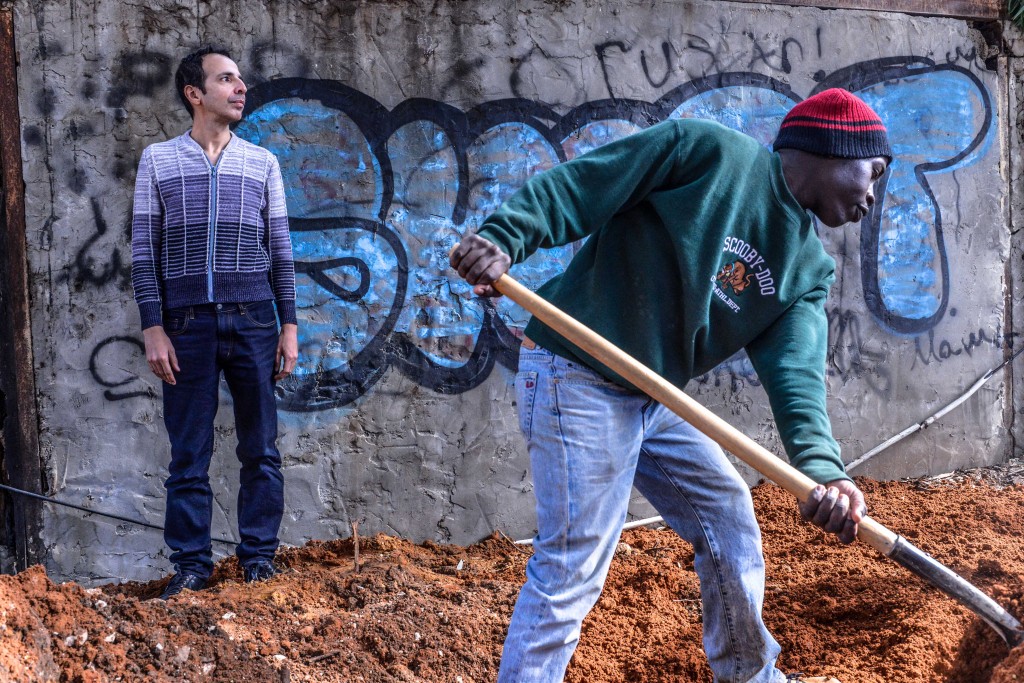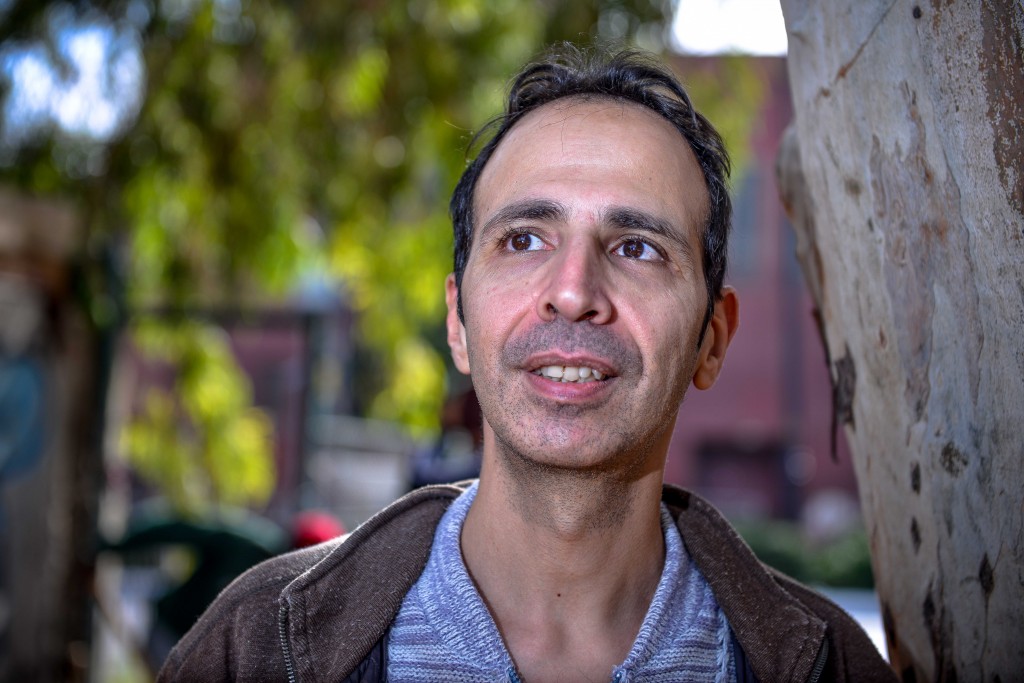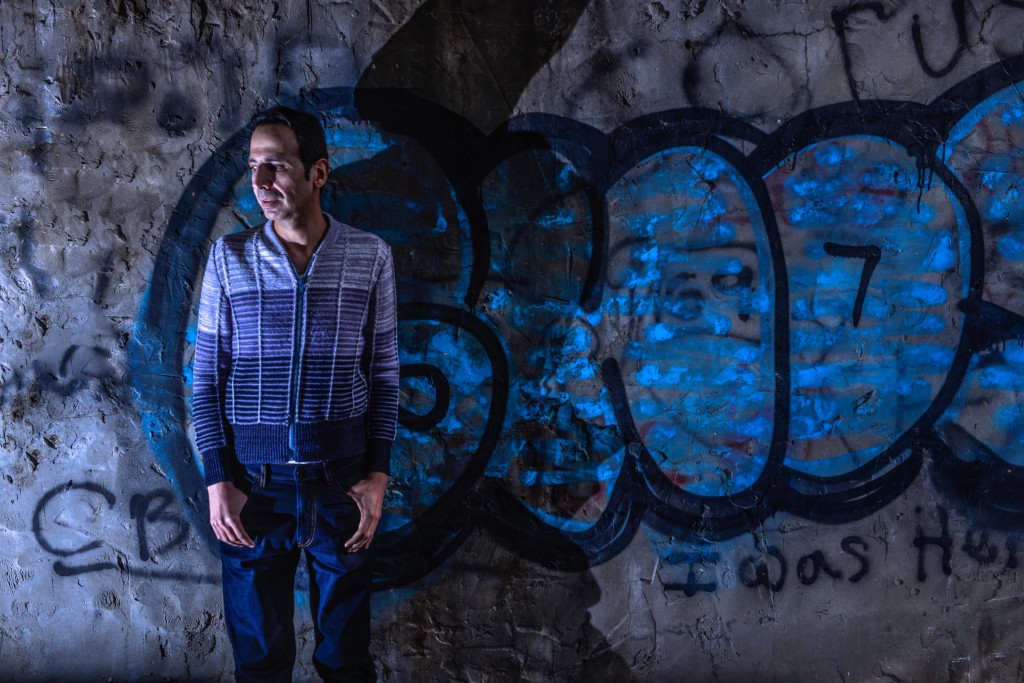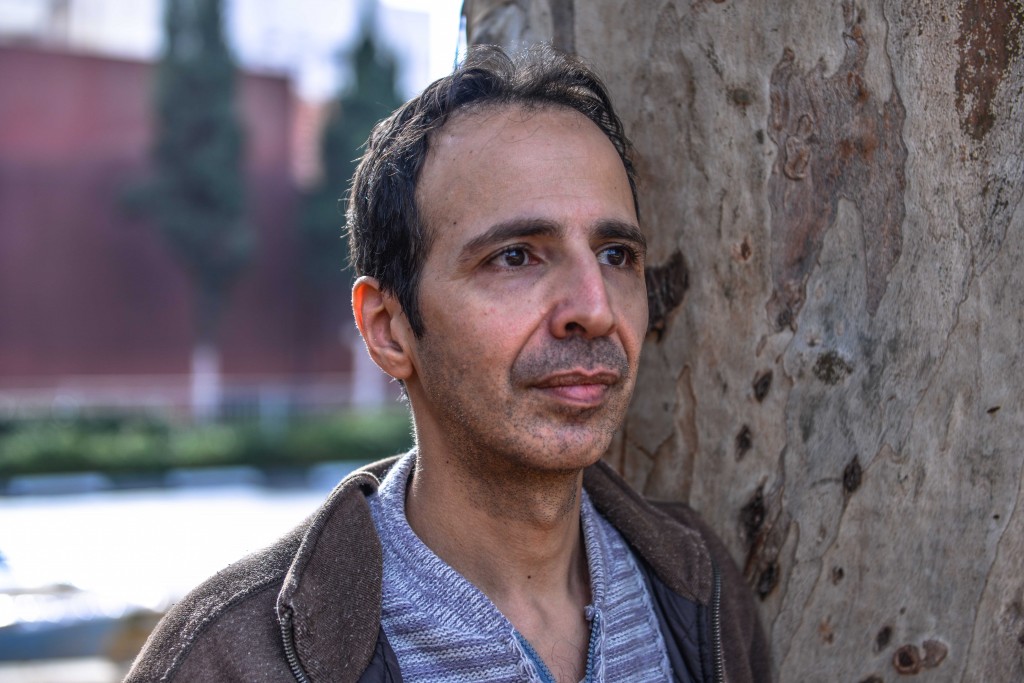In which we discover how a writer who breaks the bounds of eternity teaches us to live with our past. Photos: Aviram Valdman
Ofir Touché Gafla is the kind of writer whose readers pounce on complete strangers in bookstores and tell them, “You must read this book!” before handing them one of his five novels. This is no exaggeration. It actually happened to my friend Shira Atik, a Hebrew translator, the last time she found herself in a Steimatzky, Israel’s largest chain of bookstores and was handed The Day the Music Died. I am almost certain she is not the only one to have this experience. Especially after Gafla told me over lunch that fans write to him about how much they love his books, yet are afraid to meet him in person for fear they will be disappointed. He tells them, “Okay, don’t meet me. No reason to if you are so worried.”
To all fans: Don’t feel that way. Gafla is as charming and easygoing in person as he is on the page. His books aren’t all sweetness, but the same demonstrative nature that makes him give me a hug at our first meeting dominates his persona as much as his writing. If Gafla is anything, he is genuine.
Of course, such a greeting may have come from the feeling that we have met before, albeit only via Skype. We’ve conversed and had a relationship that informs who we are now. This sense of the past intercut with the present is very much part of Gafla’s first novel, The World of the End, the only one translated into English. To me, it seems a particularly Israeli approach to life: Living in the present with a constant awareness of what it means to have a past.
The World of the End is titled Olam Hasof in Hebrew, a title with typically multiple meanings. It can also be read as “eternity’s end” or “world’s end,” and plays with a Hebrew euphemism for death: “halach l’olamo”; literally, “he went to his world.” As the book’s editor, Shimon Adaf, pointed out to me in an email, the phrase “halach l’olamo,” originates in Ecclesiastes 12:5, “Man goes to his eternal home.” He added, “Olam in biblical Hebrew indicates time, not space.” The title is also a play on a phrase earlier in Ecclesiastes 1:4, which refers to the “continuous existence” of the world: “v’ha’aretz l’olam omadet”; literally, “the world stands forever.” Indeed, what makes The World of the End so unique is its willingness to play with the question of what “the end” might mean in terms of both the world of time and the world of space.
Gafla’s fascination with such things seems to have begun early. He was the kind of kid who sat in the movie theater after the film was over and asked, “What do you mean, ‘The End’?” He wanted to know, “What happens next?” It isn’t surprising, then, that his first novel deals with the “world of the end.” The book’s protagonist is a man equally obsessed with endings. In fact, endings are his profession. Ben Mendelssohn is a “righter/writer,” a translation of yet another of Gafla’s plays on words; in this case, the Hebrew word for “writer” (sofer) and the pun “sof-er” or “end-maker.” Ben writes endings for works by others, a talent he discovers when he happens to provide a screenwriter with a valid resolution for what had been an intractable plot difficulty. Ben is promptly hired, and his career as a writer of endings is born.
The book opens with Ben holding a birthday party for his wife Marian, who has died in a freak accident 15 months earlier. Marian, who taught high school literature, fell from a Ferris wheel during a class trip. Unbeknownst to his guests, Ben has decided to join his wife in the afterworld. He asks them to go outside and watch the fireworks he has planned. When they return, they find that Ben has shot himself. His final note says that he wanted to join Marian and the guests should eat the birthday cake, which has been inscribed, “And They Died Happily Ever After.”
But the afterlife does not prove to be as simple as Ben imagines. Once he finds himself in the next world, he cannot find Marian. The rest of the book cuts back and forth between his quest to find her with the help of an afterwordly private detective, and the events set in motion by his and Marian’s deaths. The latter include the tales of a nurse who likes to pull the plug on comatose patients (who lie “between the worlds”), a cranky artist who refuses to paint portraits, a beggar who was at the Ferris wheel when Marian died, as well as several other characters. As he continues on his quest, Ben encounters many relatives who have passed on, and even some he has yet to meet, like the child he and Marian never had. The Mad Hop, the detective Ben hires, tells him that the real difficulty is “You’re incapable of handling the fact that your story may have an open-ended finish.”
It must be admitted that one of the pleasures of Gafla’s work is his consoling vision of the afterlife; a place where the dead have all eternity to do the things they left undone in life—read, listen to music, watch movies, and travel. One is given a device to control the weather and to speak all languages, Orson Welles is making a new movie that will knock Citizen Kane off the list of the top 10 films ever made, Marilyn Monroe is evading paparazzi, actors flock to 17th-century Stratford to audition for Shakespeare’s final play, and Ben’s grandparents decide to retrace their family roots—back to Adam and Eve.
The central image of Gafla’s afterworld appears in a chapter called “Trunkation.” It is a forest of family trees, each of which represents a single individual in the world of the living. When a person’s life is over, the tree comes down. When something goes wrong in one world, the tree becomes deformed. An “oversecretion of sap,” for example, which “points to grave existential concern” or “severe autumnal trauma,” comes from a tree whose leaves “do not prove to be self-regenerating.”
In keeping with the multiple permutations of its title, The World of the End is very much concerned with how worlds overlap and the past infuses the present. At the end of the book, Ben asks Marian, “Do you remember the difference between past and present? Can you discern between the two?” This question is, I think, uniquely Israeli, born of a society that is always aware of the past lurking just behind the veil of the present.
Indeed, Gafla told me in a Skype conversation that the idea for the novel came from his own personal experience. When a friend of his died in a car accident at 27, he began to wonder what the dead might be aware of. “Whenever I think of her,” he said,
I think of her as living, because the only memories we have are from living people. She continues to exist in my mind. She was a musician. When I play a CD that I think she will like, I think of her. A month after she died a CD came out by Portishead, a British band. I remember I went out to buy the CD and thought, there is no way she doesn’t know about this CD. So I was thinking about the idea of ending. What does it mean…? And then I thought, let’s write a story about a person who is writing endings for a living, who is looking for an ending to his own story.
Despite his obsession with endings and the world of the dead, however, Gafla does not consider himself a pessimist. “I think that this book is about the idea of possibility,”
he tells me.
People’s notions or idea of the process. What comes afterward, what they think, what they have been told over the years. It was very important to me that, if I talk about something like the afterlife, it would be unlike any of the conventional afterlives that you read or hear about, since there always has to be an alternative to familiar ideas. The very idea of an alternative is incredibly comforting.
I was reminded of something Gafla has said in prior interviews: That The World of the End is concerned with British philosopher Roger Scruton’s claim, “The consolation of imaginary things is not imaginary consolation.”
Gafla teaches at the Sam Spiegel School of Film and Television in Jerusalem. Over lunch at the Tmol Shilshom bookstore and restaurant, he tells me that when he teaches, he feels like Mick Jagger giving a performance. When we enter his classroom, I sense that he’s right. Even though informality reigns in Israel and students call Gafla by his nickname “Touché,” a sense of respect permeates the class. The students know Gafla is a writer himself, not just a teacher, and that he understands the struggle of the fledgling writer.
For this class, students were assigned to take a text and write a scene that parallels it, but also deviates from it in the direction of the student’s own preoccupations. The range of texts the students choose is incredibly wide: Israeli poet Hanoch Levin, Japanese writer Haruki Murakami, Israeli Nobel Laureate S.Y. Agnon, David Grossman’s Falling Out of Time (which will be published in English in March 2014), Gary Shteyngart, Etgar Keret, Mark Twain, and Yoram Kaniuk, among others.
Gafla says of the assignment that he is interested in seeing students challenge themselves. If they like one kind of writing, he encourages them to read another kind, because the point of reading is to “expand your horizons.” Gafla himself reads widely. He loves Salman Rushdie, Margaret Atwood, Kate Atkinson, John Banville, William Boyd, Kazuo Ishigoro, Iris Murdoch, and Philip Roth, among others. Because Israelis seem more comfortable with seeing and saying things in a straight, blunt manner, without subtext, Gafla encourages his students to read Japanese writers like Murakami and Kazuo Ishiguro, where everything is under the surface. During class, he jokes about Hebraicizing the names of Japanese writers: Ishiguro becomes “ish she’hu guru,” the “man who is a guru,” and a student named Uri who likes Murakami is told that he can be Uriki.
His students’ variations on the texts naturally turn toward life in Israel. One student ends his piece by saying that a character got six million Facebook likes. A young woman takes a poem by Hanoch Levin about a child’s youth being taken away too quickly by the reality of Israeli life, and turns it into a piece about girls cutting the braids off their Barbie dolls.
When Gafla’s class is over, I ask to see the rest of the school. We go to the student lounge and find the one native English-speaker at the school. Aleeza Chanowitz, originally from Brooklyn, tells me that Gafla is a teacher who is “very open to our thoughts and what we have to say.” She appreciates how he can both “be everybody’s friend” and also “demand respect and get it.” In particular, he can help people “open up,” so they are able to write more personal things and “build a language to tell stories, to tell the story in an interesting way.” His assignments, she tells me, are about creating a character with a past, present, and future. Many other students appear to feel the same. In the school library, Gafla finds only two of his books on the shelves. Students have made off with the others.
As we leave the school and enter the Talpiot industrial zone, I am struck by the liveliness of the place—the students have painted murals in the student lounge and crank up the music during lunch hour—in contrast to its surroundings. The rows of industrial buildings nearby are home to a Domino’s Pizza, a bakery, a print shop, a sign shop, an interdisciplinary center for mind-body balance that has closed down, a laser toner cartridge shop, and the Israeli Free Loan Association. It occurs to me that the imaginations at work in the school are a sort of free loan, a fortunate chance for students to take the materials at hand and create something wholly new.
Over lunch, Gafla tells me how he got started as a writer. After the army, he worked at a record store for two years. When he had saved enough money, he went to England for a few months, rented a place, and wrote screenplays. He says this was “like my university; I’m self-taught.” He returned to Israel and worked various odd jobs, but all the while he kept writing.
The Israeli publishing industry has no layer of literary agents as in America. Everything must be directly submitted to an editor. Gafla tells me about how he met Shimon Adaf, the man he calls “my editor in shining armor” and “definitely the best reader ever.” In the acknowledgements section of the Hebrew version of The World of the End, he refers to Adaf as “an editor truly from another world.”
One day, Gafla read a newspaper interview with Adaf, who was then a new young editor at Keter Publishing. For Gafla, it was a revelation. Everything Adaf said resonated with him. A single thought came to him: “He is the right person.” Though Gafla tells me he is “not a pushy person,” he found Adaf’s home address and sent him the first three chapters of a novel, Ulai Nafla Ruchi (literally, “perhaps my spirit has fallen”). Adaf contacted Gafla a month later and they tried to set up a meeting. Gafla was on reserve duty and then scheduled to travel to the Dutch city of Rotterdam for a wedding. Adaf (himself the author of three books of poetry and six novels) was coincidentally speaking at a poetry festival in Rotterdam at the same time. They managed to meet there and spoke for three hours. Adaf thought Gafla’s work was the best thing he’d read all year but, in his opinion, the manuscript wasn’t publishable. He asked about other ideas Gafla might have. One of them led to The World of the End.
They met again in Tel Aviv in the early 2000s, at the height of the second intifada, when buses and cafes were being attacked constantly. With the gallows humor necessary to cope with the situation, they joked about whether publishing houses employed terrorists. Why? Because if the author were blown up, he would become a myth, the larger-than-life guy who died before his book came out. The sales would go through the roof.
Thankfully, both Adaf and Gafla were spared that fate. The World of the End came out in Hebrew in 2004 and English in 2013. Adaf proceeded to edit Gafla’s first three books, until he left to teach creative writing at Ben-Gurion University and concentrate on his own burgeoning writing career (he won the Sapir Prize, Israel’s biggest literary award, in February 2013). But his relationship with Adaf continues to be one of the most important of Gafla’s professional life. Adaf is no longer his editor but remains his first reader, and the two remain close friends. They meet every seven or eight weeks in Tel Aviv to have dinner and long conversations. Yet neither has ever been to the other’s home. They are both, Gafla tells me, extremely private people. Indeed, Adaf told me via email that “I doubt my input about Touché can contribute to your piece,” while stressing that Gafla “is a fine writer.” To Gafla and Adaf, it seems, some things simply don’t need to be said.
Gafla’s translator, Mitch Ginsburg, however, has a great deal to say. Even before he was hired to translate Gafla’s work, he tells me, he had been intrigued by a piece in Ha’aretz in honor of Israeli Book Week. Each year, the editors give a single issue of the newspaper over to fiction writers. The other writers, Ginsburg says, did all kinds of things, most of them predictable, but Gafla interviewed people who control traffic lights. The piece was called “Life Behind Life.” Ginsburg immediately thought that this was a writer who “can do anything” and was completely “idiosyncratic,” because he was able to write an imaginative and wholly original piece on a mundane event. And indeed, working with Gafla proved to be a pleasure; partly because the writer is the “biggest Anglophile” Ginsburg has met in Israel, with an “insanely wide frame of reference,” so much so that Ginsburg never knows “what he’ll be immersed in or learning about.”
To most Israeli writers, Ginsburg says, the English translation of their work is hugely important, because their international reputation is almost entirely dependent on it. At times, they even see it as another rewrite, a second chance to change things. But Gafla, he comments, is exceptional even in this case. He has an excellent command of English and reads widely in it. The two men can spend upwards of 50 hours on the phone poring over every word, even the way sentences sound. Although translating Gafla is terribly difficult because of the author’s tireless word play and love of lush language, this work is nonetheless blissfully free of particular references to modern Israel that might be incomprehensible to the foreign reader; mainly because so much of the book takes place in the afterlife, a completely mythical place where a common language exists.
At the moment, the English-language world seems to be embracing Gafla as much as he embraces it. The World of the End was recently chosen by Kirkus Reviews as one of ten books that “sweep you off your feet and put you somewhere,” that “suck us into evocative worlds,” and “not only captivate you with the universe they create but take you to places that are slightly off-kilter.”
But Gafla has a somewhat different view of his work, one that is deeply connected to a very Israeli sense of memory and reality. In our final conversation at the King David Hotel in Jerusalem, Gafla told me that despite what others see as the themes and preoccupations of his novels, he does not write about death. He writes about the “life before or after… around the black holes” of death, which he does not “overlook or ignore.” He tells me that “memory” is a major theme in all his novels, “some more apparent than others.”
He turns personal, telling me that his father Menachem had a fall in August 2013 that affected his mind. “The thing that scares me the most,” Gafla says, is losing his memory, since “memories are your identity.” While he does not fear death, he does fear not having enough time to complete the work he wants to do. His philosophy is to always “keep moving”; he has “so many projects” that he “needs to take care of.”
In an email, I asked explicitly if his books, with their emphasis on memory, connect the past and present. He responded eloquently,
I have always been fascinated with what Marcel Proust referred to as “the ungraspable gap between memory and nothingness.” It is the core of my creation. My constant wonderment at the shocking profusion of life as embodied by the human memory versus the no less shocking void surrounding it; almost as if our very existence is merely a dream and our fellow humans, or fellow dreamers, are nothing but conspirators in this wild scheme. Some people think my books are about death; but they’re wrong, simply because death is nothing. I’m interested in life in all its splendor. But I never forget that there’s this cloud hovering above. I don’t understand how one can give life some serious thought and ignore death. Not for the sake of being morbid, but rather as a fait accompli which might lend one a more profound perspective on life.
At the King David Hotel, it is late, we are both tired, and Gafla must be ready to teach in the morning. Yet I have no enthusiasm for leaving. I find that sitting and talking to him, with the breadth of his imagination, is a transport elsewhere, a going to another place. I recall an email he sent me earlier about writing: “Perhaps being a writer is all about greed,” he wrote. “Our study (the room and the vocation) affords us manifold lives, without the hassle of reincarnation. We want it all in this lifetime, in the comfort of our private rooms, and we are enriched by all of these experiences. Such a shame that every life has so many goddamn drafts.”
In the end, of course, we leave the King David and hug as we part. He takes a cab to his hotel. Soon he will use his imagination to once again start another draft, where worlds are connected and memory ever-present.
Last fall, I reviewed The World of the End and emailed Gafla to let him know the piece would be running. I happened to be at a writer’s residency at the time, revising my novel with a view of horses and the Shenandoah Mountains from my window. I described the view to him. Gafla wrote back to me, “Good luck with your revising job. Enjoy the mountains, the horses, and the words. They’re all part of the same world.”
His words stayed with me, and months later, I still recall this message. In a country like Israel, with its intense connection to ancient things, its spiritual gravity, its traumatic past and often brutal present, this sense of connectedness, as well as the consciousness of how the past informs the present, seems to express something fundamental. To me, this interconnection of worlds, of memory and imagination, of life and the unavoidable domain of the dead, is what makes Gafla’s work both unique and quintessentially Israeli.
![]()
All photos: Aviram Valdman / The Tower









